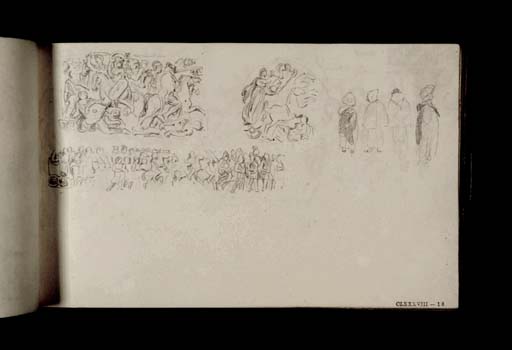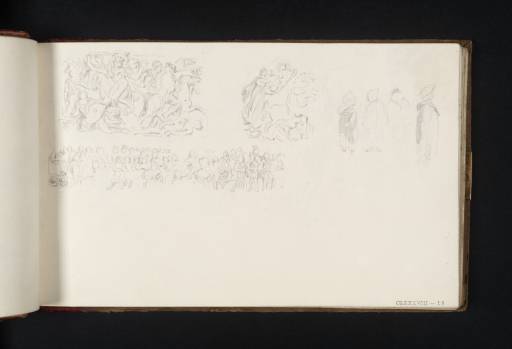Joseph Mallord William Turner Details of the Sculptures from the East End of the Arch of Constantine, Rome; Also Sketch of Four Figures 1819
Image 1 of 2
-
 Joseph Mallord William Turner, Details of the Sculptures from the East End of the Arch of Constantine, Rome; Also Sketch of Four Figures 1819
Joseph Mallord William Turner, Details of the Sculptures from the East End of the Arch of Constantine, Rome; Also Sketch of Four Figures 1819 -
 Joseph Mallord William Turner, Details of the Sculptures from the East End of the Arch of Constantine, Rome; Also Sketch of Four Figures 1819 (Enhanced image)Enhanced image
Joseph Mallord William Turner, Details of the Sculptures from the East End of the Arch of Constantine, Rome; Also Sketch of Four Figures 1819 (Enhanced image)Enhanced image
Joseph Mallord William Turner,
Details of the Sculptures from the East End of the Arch of Constantine, Rome; Also Sketch of Four Figures
1819
Joseph Mallord William Turner 1775–1851
Folio 18 Recto:
Details of the Sculptures from the East End of the Arch of Constantine, Rome; Also Sketch of Four Figures 1819
D16190
Turner Bequest CLXXXVIII 18
Turner Bequest CLXXXVIII 18
Pencil on white wove paper, 114 x 189 mm
Stamped in black ‘CLXXXVIII 18’ bottom right
Accepted by the nation as part of the Turner Bequest 1856
References
1909
A.J. Finberg, A Complete Inventory of the Drawings of the Turner Bequest, London 1909, vol.I, p.558, as ‘Details of sculptures on the (1) East Attic, and (2 and 3) one of the side of the arch of Constantine; also (4) figures of priests looking up. (see Plates 48 and 104 of Strong’s “Roman Sculpture.”)’.
1984
Cecilia Powell, ‘Turner on Classic Ground: His Visits to Central and Southern Italy and Related Paintings and Drawings’, unpublished Ph.D thesis, Courtauld Institute of Art, University of London 1984, pp.129 and 476 note 10, 145 note 78.
1987
Cecilia Powell, Turner in the South: Rome, Naples, Florence, New Haven and London 1987, pp.51 note 8, 59 note 43.
Like many other ancient monuments in the Roman Forum, Turner made a detailed study of the Arch of Constantine, a triumphal arch which stands at the eastern end of the Forum, near to the Colosseum. The three sketches on this page record the separate elements on the eastern end of the arch (the end nearest the Colosseum). In the top left-hand corner is the bas-relief panel of a battle scene found on the eastern attic. To the right is a sketch of the tondo positioned on the eastern façade which shows an allegorical depiction of the goddess of the dawn, Aurora, rising from the sea with a quadriga, a chariot drawn by four horses.1 Finally, the narrow sketch beneath records the frieze placed beneath the roundel which depicts the triumphal entry into Rome of Emperor Constantine and his soldiers after the Battle of the Milvian Bridge in AD 312. For further studies of the Arch of Constantine see folios 20–23 (D17158; Turner Bequest CXCV a H and D16194–D16197; Turner Bequest CLXXXVIII 20–22). See also the Small Roman C. Studies sketchbook (Tate D16396, D16398, D16416 and D16455; Turner Bequest CXC 2, 4, 15a and 41) and the Rome: C. Studies sketchbook (Tate D16355 and D16367; Turner Bequest CLXXXIX 29 and 40).
Cecilia Powell has suggested that Turner’s sketch of the ‘dawn’ medallion may have been an iconographical source of inspiration for his later oil painting, Ulysses deriding Polyphemus exhibited 1829 (National Gallery, London).2 The roundel shows Aurora holding her son, Phosphorus, the boy carrying a torch who personifies the morning star. Powell, following John Gage, argues that the nereids in the foreground at the prow of the ship may refer to phosphorescence, and hence recall Turner’s knowledge of classical mythology cultivated during his study of Roman antiquities.3
In the top right-hand corner of the page, Turner has drawn a quick study of four figures, possibly wearing religious robes. He possibly observed them, like himself, looking up at the monuments of the Forum.
Nicola Moorby
September 2008
How to cite
Nicola Moorby, ‘Details of the Sculptures from the East End of the Arch of Constantine, Rome; Also Sketch of Four Figures 1819 by Joseph Mallord William Turner’, catalogue entry, September 2008, in David Blayney Brown (ed.), J.M.W. Turner: Sketchbooks, Drawings and Watercolours, Tate Research Publication, December 2012, https://www

